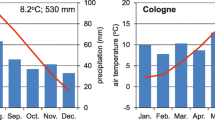Summary
A computer-assisted weather categorization was applied to meteorological time series measured at the Milešovka Observatory (a mountain station) and Prague-Klementinum (an inner city site). Groups of winter days (December, January and February) with extreme mean temperatures were examined with respect to their frequency of occurrence and presence of any trends in the period 1941–1988. In general, frequencies of cold categories exhibited a decreasing trend, and frequencies of warm categories tended to increase. In both series a prominent negative trend in temperature amplitude was detected within warm clusters, related to a statistically insignificant decline in the maximum temperature and an increase in the minimum temperature. Additional analysis indicates that changes in circulation patterns occurred over the region during the period investigated, namely strengthening of zonal circulation in winter.
Similar content being viewed by others
References
Balling, R. C., Skindlov, J. A., Phillips, D. H., 1990: The impact of increasing summer mean temperatures on extreme maximum and minimum temperatures in Phoenix. Arizona.J. Climate 3, 1491–1494.
Bárdossy, A., Caspary, H. J., 1990: Detection of climate change in Europe by analyzing European atmospheric circulation patterns.Theor. Appl. Climatol. 42, 155–167.
Böhm, R., 1986:Der Sonnblick-Die hundertjährige Geschichte des Observatoriums und seiner Forschungstätigkeit. Wien: OBV, 224pp.
Brázdil, R., 1991: Variability of meteorological series in Central Europe in the instrumental period. (In Czech). National Climate Programme. 2. CHMU. Prague. 56pp.
Bücher, A., Dessens, J., 1991: Secular trend of surface temperature at an elevated observatory in the Pyrenees.J. Climate 4, 859–868.
Cleveland, W. S., 1979: Robust locally weighted regression and smoothing scatterplots.J. Am. Stat. Assoc. 74, 829–836.
Davis, R. E., Walker, D. R., 1992: An upper-air synoptic climatology of the western United States.J. Climate 5, 1449–1467.
Gerstengarbe, F.-W., Werner, P. C., 1992: The time structure of extreme summers in Central Europe between 1901 and 1980.Meteorol. Zeitschrift. N. F.,1, 285–289.
Gong, X., Richman, M. B., 1992: An examination of methodological issues in clustering North American precipitation. In: 12th Conf. on Probability and Statistics in the Atmospheric Sciences. Toronto. J103–J108.
Grady, A. M., 1992: Modeling daily minimum temperature: An application of the threshold method. In: Proc. 5th Int. Meeting on Statistical Climatology. Toronto. 319–324.
Hansen, J., Fung, I., Lacis, A., Rind, D., Lebedeff, S., Ruedy R., Russel, G., Stone, P., 1988: Global climate changes as forecast by Goddard Institute for Space Studies threedimensional model.J. Geophys. Res. 93D, 9341–9364.
Houghton, J. T., Jenkins, G. J., Ephraums. J. J. (eds.), 1990:Climate Change: The IPCC Scientific Assessment. Cambridge: Cambridge University Press.
Huth, R., Nemešová, I., Klimperová, N., 1993: Weather categorization based on the average linkage clustering technique: An application to European mid-latitudes.Int. J. Climatol. 13, 817–835.
Kalkstein, L. S., Corrigan, P., 1986: A synoptic climatological approach for geographic analysis: assessment of sulphur dioxide concentrations.Ann. Assoc. Am. Geogr. 76, 381–395.
Kalkstein, L. S., Tan, G., Skindlov, J. A., 1987: An evaluation of three clustering procedures for use in synoptic climatological classification.J. Climate Appl. Meteor. 26, 717–730.
Kalkstein, L. S., Dunne, P. C., Vose, R. S., 1990: Detection of climatic change in the western North American Arctic using a synoptic climatological approach.J. Climate 3, 1153–1167.
Knox, J. L., Higuchi, K., Shabbar, A., Sargent, N. E., 1988: Secular variation of Northern Hemisphere 50kPa geopotential height.J. Climate 1, 500–511.
Lukasová, A., Šarmanová, J., 1985:Cluster Analysis Methods. (in Czech). Prague: SNTL. 210pp.
Nemešová, I., Huth, R., Klimperová, N., 1993: An approach to the assessment of climatic trends. In: Proc. Precipitation variability and climate change. Vol. 2., Bratislava, 93–99.
Preisendorfer, R. W., Mobley, C. D., 1988:Principal Component Analysis in Meteorology and Oceanography. Amsterdam: Elsevier.
Schönwiese, C.-D., Rapp, J., Fuchs, T., Denhard, M., 1994: Observed climate trends in Europe 1891–1990.Meteorol. Zeitschrift, N. F.3, 22–28.
Shabbar, A., Higuchi, J., Knox, J. L., 1990: Regional analysis of Northern Hemisphere 50 kPa geopotential heights from 1946 to 1985.J. Climate 3, 543–557.
Stone, R. C., 1989: Weather types at Brisbane, Queensland: An example of the use of principal components and cluster analysis.Int. J. Climatol. 9, 3–32.
Stooksbury, D. E., Michaels, P. J., 1991: Cluster analysis of southeastern U.S. climate stations.Theor. Appl. Climatol. 44, 143–150.
Author information
Authors and Affiliations
Additional information
With 6 Figures
Rights and permissions
About this article
Cite this article
Nemešová, I., Klimperová, N. Weather categorization — a useful tool for assessing climatic trends. Theor Appl Climatol 51, 39–49 (1995). https://doi.org/10.1007/BF00865538
Received:
Issue Date:
DOI: https://doi.org/10.1007/BF00865538




